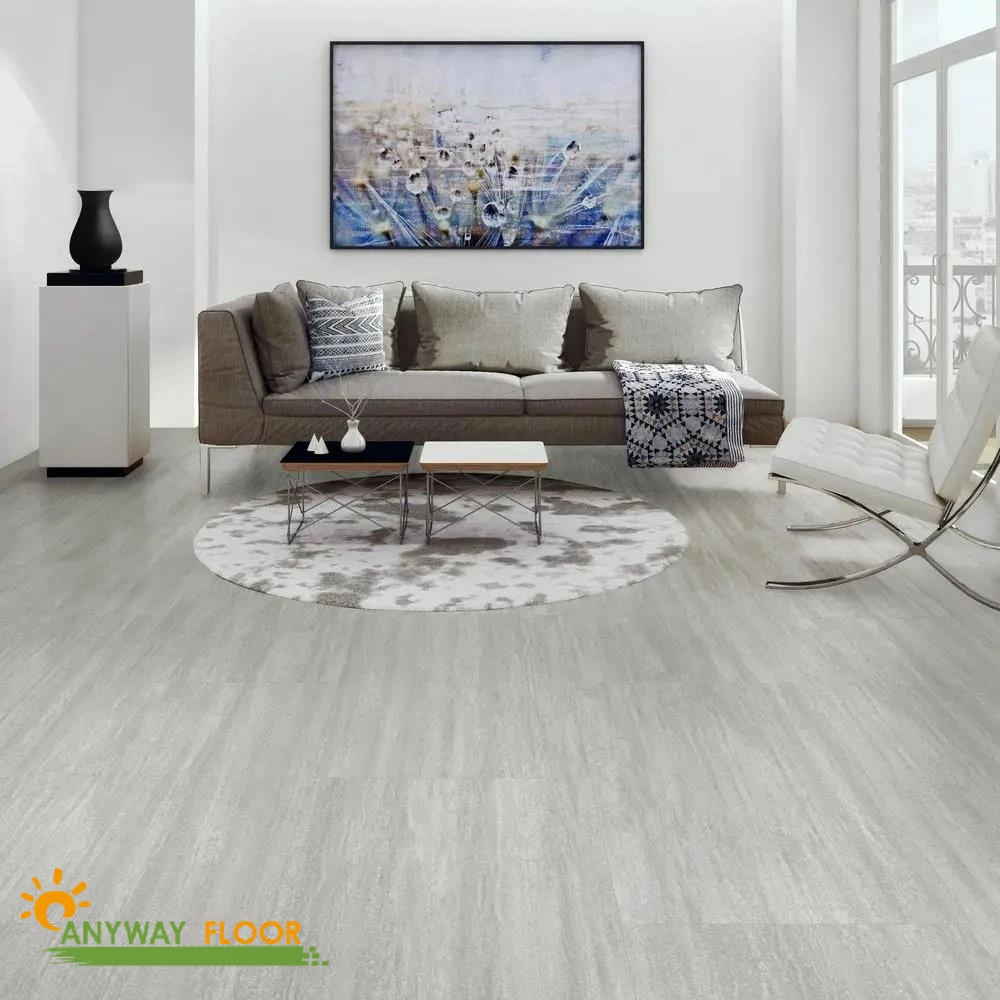Views: 31 Author: Site Editor Publish Time: 2024-01-18 Origin: Site









Exploring the Water Resistance in Laminate Flooring: A Comprehensive Analysis
The key to laminate flooring's popularity lies in its composition. The wear layer, positioned at the top, acts as a shield against wear and tear, stains, and moisture. This transparent coating not only enhances the visual appeal of the floor but also plays a crucial role in protecting it from external elements. Just beneath the wear layer, the decorative layer replicates the look of natural materials like wood or stone, providing the aesthetic charm that often makes laminate a preferred flooring option.
The core layer, typically constructed from high-density fiberboard (HDF) or medium-density fiberboard (MDF), serves as the backbone of laminate flooring. This layer imparts stability and strength to the flooring, ensuring its durability over time. What sets laminate apart is its ability to resist moisture, a characteristic primarily attributed to the moisture-resistant properties of HDF or MDF.The backing layer, forming the bottommost part of the laminate structure, provides additional support and reinforces moisture resistance. This multi-layered approach to construction forms a formidable barrier against water infiltration, making laminate flooring a suitable choice for areas where occasional spills or damp conditions are expected.
In the subsequent sections of this article, we will delve deeper into the specific features that enhance the water resistance of laminate flooring, shedding light on how it tackles challenges such as seams, edges, and subfloor conditions. By understanding the nuances of water resistance in laminate flooring, homeowners and designers can make informed decisions about its application and maintenance in various settings.
Water-Resistant Properties
The inherent water-resistant characteristics of laminate flooring stem from the synergistic functionality of its key components, namely the wear layer and the core material. The wear layer, situated atop the laminate structure, serves as a formidable barrier against spills and stains, acting as a shield that prevents water from infiltrating into the core. Simultaneously, the core layer, crafted from high-density fiberboard (HDF) or medium-density fiberboard (MDF), plays a pivotal role in resisting moisture absorption.

Expanding on the pivotal features that augment water resistance:
1. HDF/MDF Core:
The choice of HDF or MDF in the core layer is instrumental in enhancing the water-resistant properties of laminate flooring. Unlike traditional wood-based cores, HDF and MDF exhibit reduced susceptibility to expansion and contraction when exposed to moisture, ensuring the structural integrity of the flooring over time.
2. Moisture-Resistant Coating:
Some laminate flooring variants are equipped with an additional moisture-resistant coating on the surface. This supplementary layer acts as an extra line of defense, further diminishing the risk of water damage. It reinforces the flooring's ability to withstand occasional spills and provides an added layer of protection against environmental elements.
3. Click-and-Lock Installation System:
A prevalent feature in laminate flooring is the click-and-lock installation system, facilitating a snug interlocking mechanism between individual planks. This tight seam formation prevents water from penetrating the joints, fortifying the overall water resistance of the floor. The seamless integration of planks minimizes the risk of moisture seeping through the flooring, making it a reliable choice for areas prone to damp conditions.
Limitations of Water Resistance
While laminate flooring is known for its impressive water resistance, it is crucial to recognize its inherent limitations, as certain conditions can compromise its performance. Understanding these factors is essential for maintaining the longevity of laminate flooring:
1. Seams and Edges:
The seams between laminate planks and the edges of the flooring are susceptible points where water can potentially infiltrate. Despite the water-resistant design, prolonged exposure to standing water or excessive spills may challenge the protective measures. Therefore, it is imperative to promptly clean up spills and moisture to prevent water from seeping into these vulnerable areas, safeguarding the integrity of the flooring.
2. Core Material:
The core material, typically composed of HDF or MDF, enhances the water resistance of laminate flooring. However, it is important to note that while these materials are more resistant to moisture than solid wood, they are not entirely waterproof. Extended exposure to standing water can lead to swelling and damage to the core, potentially compromising the structural integrity of the flooring. It underscores the importance of promptly addressing water-related issues to mitigate the risk of long-term damage.

3. Subfloor Conditions:
The condition of the subfloor beneath the laminate flooring plays a critical role in its overall water resistance. If the subfloor is not adequately prepared or if issues such as moisture infiltration exist, they can adversely impact the performance of the laminate flooring. Addressing subfloor concerns, ensuring proper installation, and implementing moisture mitigation measures are essential steps to optimize the water resistance of laminate flooring in diverse environments.
Maintenance and Care Tips
Ensuring the longevity and water resistance of laminate flooring involves adopting diligent maintenance and care practices. Here are essential tips to preserve the beauty and functionality of your laminate floors:
1. Prompt Spill Cleanup:
Accidents are inevitable, but prompt action is key. Wipe up spills immediately to prevent water from infiltrating the seams and edges of the laminate flooring. Swift cleanup minimizes the risk of water-related damage and preserves the integrity of the floor's protective layers.
2. Use Rugs or Mats:
Strategically placing rugs or mats in high-traffic areas, near entryways, and in front of sinks can act as a protective barrier. These accessories are effective in catching water and debris, preventing them from reaching the laminate floor. Regularly clean or shake out rugs to ensure they remain efficient in safeguarding the flooring.
3. Avoid Excessive Water:
When it comes to cleaning laminate floors, moderation is key. Use a damp cloth or mop rather than saturating the floor with excessive water. Water seeping into the seams and edges can compromise the water-resistant properties of the flooring. Additionally, excessive moisture can lead to swelling and warping of the laminate boards, affecting their overall stability.
4. Choose the Right Cleaning Products:
Opt for cleaning products specifically formulated for laminate flooring. Abrasive cleaners, wax, and oil-based products can damage the protective wear layer, diminishing the floor's resistance to water and stains. Follow manufacturer recommendations for approved cleaning solutions to maintain the integrity of the flooring.
5. Regular Sweeping and Vacuuming:
Regularly sweep or vacuum the laminate floor to remove dirt, dust, and debris. Small particles can act as abrasives, causing scratches over time. Use a soft-bristle broom or a vacuum with a soft brush attachment to keep the floor clean without causing damage.
6. Protect Furniture Legs:
Attach felt or rubber protectors to the legs of furniture to prevent scratches and dents on the laminate surface. This precaution not only maintains the aesthetic appeal of the floor but also prevents potential areas for water to infiltrate.
7. Temperature and Humidity Control:
Maintain a consistent indoor temperature and humidity level to prevent the expansion and contraction of the laminate flooring. Drastic changes in temperature and humidity can impact the structural integrity of the floor over time.
In conclusion, the comprehensive analysis of water resistance in laminate flooring reveals its pivotal role in the flooring industry. The synergistic combination of the wear layer, decorative layer, HDF/MDF core, and moisture-resistant backing layer forms a robust defense mechanism against moisture infiltration, making laminate a preferred choice for spaces with occasional spills or damp conditions. The click-and-lock installation system further fortifies this resistance by preventing water from penetrating joints, enhancing the overall reliability of laminate flooring. However, it is imperative to acknowledge the inherent limitations, especially concerning seams, edges, core materials, and subfloor conditions. Proactive measures, such as prompt spill cleanup and strategic use of rugs, mats, and proper cleaning products, are essential to mitigate risks and preserve the integrity of laminate floors. Regular maintenance practices, including sweeping, vacuuming, and temperature control, contribute significantly to the longevity and performance of the flooring. By embracing these insights and adhering to diligent maintenance and care tips, homeowners and designers can confidently choose and install laminate flooring, ensuring its sustained water resistance and aesthetic appeal in diverse environments. The versatility and affordability of laminate flooring, coupled with proper care, position it as a resilient and attractive flooring option for years to come.
How To Clean Vinyl Floors: Simple Techniques for Shiny Results
A Comprehensive Walkthrough: Installing Water-Resistant Laminate Flooring by Anyway Flooring
Exploring the Water Resistance in Laminate Flooring: A Comprehensive Analysis
Designing Your Dream Space with SPC Flooring: Trends and Inspiration
Why SPC Flooring is the Best Choice for Your Home or Business